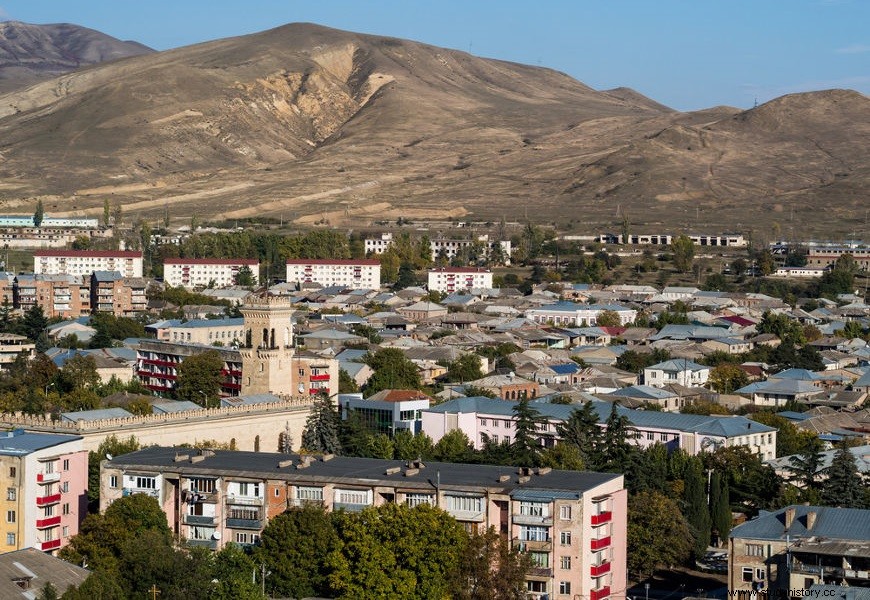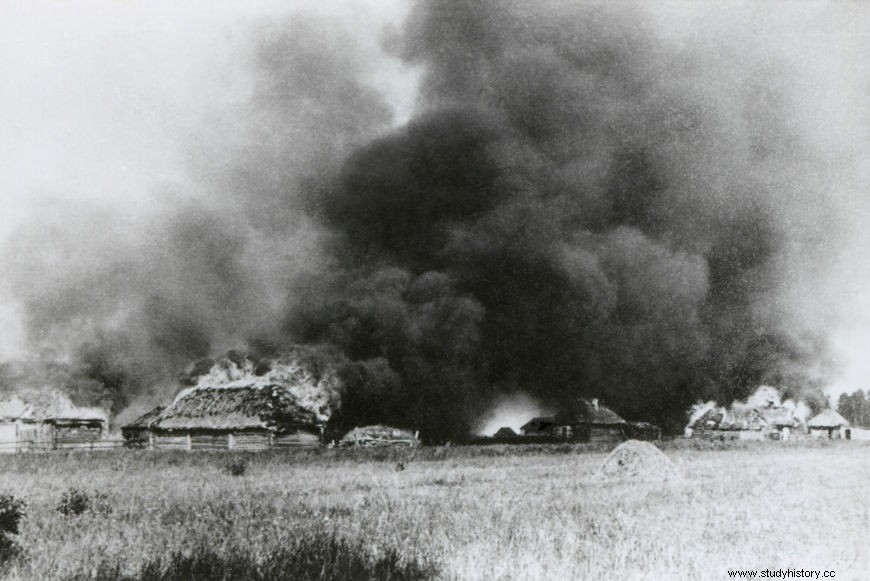Josef Stalin he is internationally known for having been one of the rulers of the Soviet Union (USSR), and his fame is attributed to the fact that he spent nearly three decades in power. During this period, Stalin implemented a totalitarian regime that persecuted and killed opponents and carried out profound transformations in the Soviet Union, making the country a true industrial power.
Stalin was also marked by leading the resistance of his country against the Nazis, when they invaded the Soviet Union, in June 1941. The defeat of the Germans in World War II turned the Soviet leader into a national hero, and it was only after his death that the crimes committed by his government were exposed. .
Login also :Moscow:discover the history of one of the most important cities in Russia
Youth

Josef Stalin was born on December 18, 1878, in city of Gori , currently located in Georgia (a country that is in the Caucasus), but which, in the 19th century, was part of the Russian Empire ruled by the tsars. The birth name of the well-known Soviet dictator was Iosif Vissarionovich Dzhugashvili .
Stalin's family was poor, and he was the only child of Vissarion Dzhugashvili and Ekaterina Geadze , who even had other children before him, but they died in infancy. Stalin's childhood was marked by poverty as his father was a shoemaker which was not successful and his mother came from a family of ex-servants and worked as a cleaner and laundress .
Stalin's relationship with his father was never good because Stalin was an alcoholic who frequently beat his wife and son. Vissarion and Ekaterina's marriage ended up failing because of the aggression and the disagreement they both had about Stalin's future. His mother wanted him to pursue a religious career, and his father to be a shoemaker.
At the age of 16, Stalin moved with his mother to Tiflis (present-day city of Tbilisi) and went on to study at a seminar religious , but despite being linked to this kind of life, he was never a devotee of Christianity. In this seminar, Stalin ended up living with the buzzing political scene from the main Georgian city, as the environment brought together secret political groups.
Revolutionary Life

As mentioned, at the religious seminary, Stalin had access to the Georgia's political turmoil of the late 19th century. In the seminary he did readings forbidden by the direction and ended up getting involved with a social democratic group called Messame Dasi . This clandestine group defended Georgia's independence from the Russian empire.
In 1899, he ended up dropping out of seminary and taking a job in Tiflis. This activity was basically a facade to hide the revolutionary life he led. During this period he was already organizing meetings and trying to convince friends to join the socialist cause he defended.
In 1901, Stalin came under observation by the Russian police, and the following year he was arrested for the first when he was carrying out an operation with workers in a town on the coast of Georgia. With that, the future leader of the USSR was sent to exile in Siberia . From 1905 Stalin joined the Bolsheviks in the division that took place within the Russian Social Democrats.
Russian Revolution
In 1905, Stalin played some part in the 1905 Revolution, known as the General Rehearsal, and ended up meeting Vladimir Lenin , during a meeting of Bolsheviks in Finland. After 12 years, the Bolsheviks had grown considerably in Russian territory and, in October 1917, they managed to seize power in Russia.
Between 1905 and 1917, Stalin carried out a series of actions in the name of the Bolsheviks and the revolution. He was arrested numerous times, but he became a notorious name, and when the revolution that brought the Bolsheviks to power took place, Stalin was involved in important bureaucratic functions. During this period he began to use the pseudonym Stalin, which means “made of steel” .
With the Bolsheviks in power, Stalin assumed administrative posts in Russia, such as the People's Commissariat for Nationalities. In the Civil War period, he was called upon to take the lead in actions against the counterrevolutionary group, which tried to overthrow the then new government.
For these and other actions, Stalin became one of the most important men in Russia along with Lenin , Trostky and Sverdlov (one of the great names of the 1917 Revolution). After the civil war, he still assumed duties in the Politburo , Communist Party committee, and in the Orgburo, Politburo subcommittee dealing with labor matters.
After the civil war, Russia was transformed into the Soviet Union, and Stalin's importance to the Soviet government was reinforced by the fact that he was named secretary-general (highest rank in the party). It was at this moment of Stalin's frank rise within the party that Lenin died .
Power struggle
The struggle for power in the Soviet Union began in 1923 due to the weakened health of its ruler. Lenin had suffered a stroke and his position as ruler weakened and left room for other party members to vie for power. The names that disputed it between 1923 and 1927 were Stalin , Trostky , Zinoviev and Kamenev .
Lenin tried to remove Stalin from his post on the grounds that he was too rude to hold the post of secretary-general. Stalin even submitted his resignation, but it was not accepted by party members, including the three who were vying with him for power in the USSR. He ended up prevailing in the race because he was a figure who rose through the party bureaucracy and was respected by its members. This support, in this matter, was more important than popular support.
In 1927, Stalin is considered to have become the de facto ruler of the Soviet Union because that is when he expels Trotsky, Kamenev and Zinoviev of the party . All three were pursued by the new ruler from that moment on. Finally, Kamenev and Zinoviev were executed in 1936 and Trotsky in 1940.
Stalin's government
Stalinism was the totalitarian regime imposed by Stalin as ruler of the Soviet Union. During his command, he imposed a industrialization and collectivization das land Soviets by force; a very strong personality cult; and the persecution of opponents and ethnic minorities, leaving a toll of approximately 20 million people dead .
In 1928, the Plan Five Year and the collectivization of land. The first tried to promote the industrialization of the USSR through goals that had to be achieved obligatorily. The second sought to nationalize the productive lands of the USSR, abolishing private farms and large farmers, called kulaks .
Collectivization generated a lot of resistance, particularly in Ukraine, and Stalin's response was to impose more repression. Millions of people were sent to forced labor camps (gulags ), which were located in remote locations such as Siberia and Kazakhstan. There was also the firing of opponents.
In the 1930s, Stalin carried out the Great Purge , which aimed to persecute all those who represented some “threat” to the revolution. This resulted in ethnic minorities and prominent Communist Party members being arrested or summarily executed. Bureaucrats and military were executed and accused of “Trotskyism”.
Login also :Holodomor:one of the consequences of the collectivization of land in Ukraine
World War II

Stalin led the Soviets during WWII. In 1939, he signed a non-aggression agreement with the Germans, and this agreement allowed him to put into practice his desires for territorial expansion. He invaded and annexed eastern Poland and tried to invade Finland but ultimately failed.
When the Nazis invaded the USSR , in June 1941, Stalin had not prepared his country for the fight against the Germans. He had ignored some warnings of an imminent German attack, as he expected the Germans to come only after 1942. This almost caused the Soviets to be defeated.
The Germans focused on three fronts:against Leningrad , at North; Moscow , in the middle; Kiev , Stalingrad and Caucasus, South. Stalin ordered the transfer of industries to the interior of the territory, the summoning of millions of soldiers and forbade them to retreat in battle under penalty of firing squad.
Such effort made by the Soviets meant that they ended up being the largely responsible for the defeat of the Nazis in the Second War. Through an agreement with the Allies, Stalin obtained authorization for the Soviet troops to be the ones to attack Berlin, in the final battle against the Nazis.
About 2.5 million troops were mobilized to conquer the German capital in April 1945, but the final toll for the Soviets was about 25 million dead. After the war, Stalin became a true hero in the Soviet Union, despite its totalitarian regime. Still in his government, the Cold War framework was formulated and the Soviets still secretly participated in the Korean War.
Login also :Katyn :the great massacre of Poles carried out by the Soviet government in 1940
Death
Stalin died, March 5, 1953 , as a result of a stroke suffered on March 1. It is believed that the Soviet leader's death was due to a lack of relief and medical care in the days after the stroke. With his death, Soviet power was taken over by Nikita Kruschev .
Khrushchev was largely responsible for putting an end to the cult of Stalin. This happened when he denounced the crimes committed by him during his rule . Khrushchev's denunciation took place at the 20th Congress of the Communist Party in 1956 and was supposed to be secret, but ended up leaking. As a consequence, a great crack in communism spread across the world, with one side defending Stalin and the other attacking him.
Login also :Understand how the end of the Soviet Union took place
Family life
In his lifetime, Stalin married twice . His two wives were:
-
Ekaterina Svanidze (married between 1906 and 1907). She died in 1907 as a result of typhus.
-
Nadezhda Alliluyeva (married between 1919 and 1932). She committed suicide in 1932.
Of these two marriages, Stalin had a total of three children. Yakov Dzhugashvili from the first marriage, and Vasily Dzhugashvili and Svetlana Alilluyeva, of the second. Between the two marriages, Stalin also had a relationship with a 13-year-old girl named Lidia Pereprygina , who lived in a small village in Siberia. From this loving relationship was born, Alexander , son he never recognized as his.
Image credits
[1] secondhand bookstores and Shutterstock
[2] Everett Historical and Shutterstock
